At the end of June, Robin Hood Legends was released. This is a new game by the Belarusian studio Neskinsoft. The game is published by Big Fish. The novelty is a puzzle in which the authors mix the principles of classic match-3 fritupley with the mechanics of Triple Town.
Why did we pay attention to the game?
First. Big Fish rarely takes a fritupley project from CIS developers to a mobile edition. The loudest story is the collaboration with the authors of Gummy Drop. If a major publisher took Robin Hood Legends and led it for a long time (since 2016), then he saw a prospect in the project.
Second. The basic mechanics (core) of the game is not widely distributed. It is not innovative, but it is not hackneyed either. Moreover, this mechanic is implemented for the first time in the framework of a multi-level casual game.
We were wondering how suitable it is for this format.
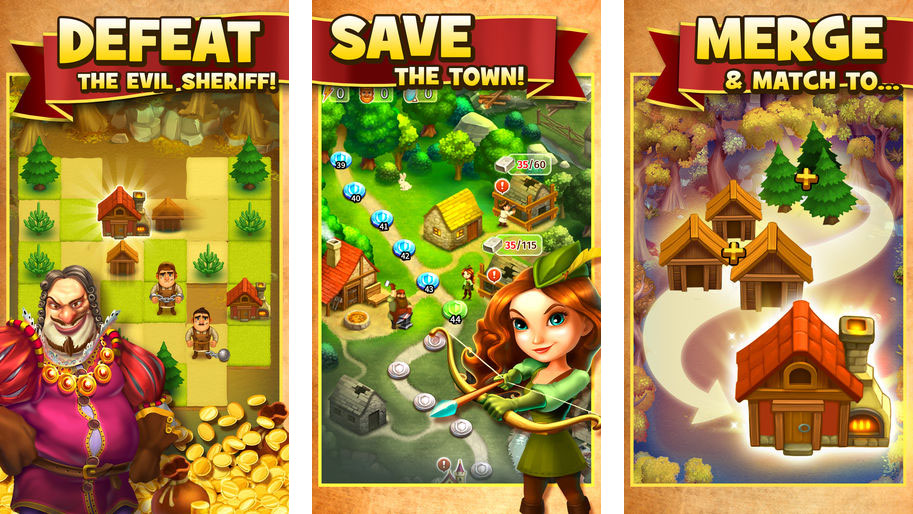
Robin Hood Legends
Six questions of deconstruction
Deconstruction is based on six questions. It is assumed that a detailed answer to each of them will give an idea of the project. These are the questions:
- What audience is the game designed for?
- What is this game about?
- What is the main gameplay of the game?
- How is the meta built in the game?
- What does the developer earn in the game?
- What are the game’s problems?
1. What audience is the game designed for?
Big Fish Games is a mobile company with a rich casual history. Its target audience is women over 35 years old. According to the concept and art of Robin Hood Legends, it is read that Sergey Neskin’s team was guided by them.
a) The main character is a woman.
b) A near-fairy-tale positive setting without violence.
c) A calm warm color palette.

The game is also suitable for a wider audience. There are no elements here that would be negatively read by any social group. The game can be considered stylistically neutral.
But due to the predominance of muted yellow and brown tones in the palette, the game at times resembles midcore projects of CIS developers. Casual games for the Western audience are usually made brighter and juicier.
Comment from the developer
Sergey, in a conversation with me, noticed that they missed this moment even at the pre-production stage: “Much later, the feeling came that the project for the juiciness of the picture was still different from other casual games presented in the stores, but by this time we had already done quite a lot of content, so we limited ourselves to polishing some moments.”
2. What is the game about?
It is considered that the plot for casual games is secondary. However, in theory, it can indirectly affect Retention and engagement (here Stikness).
There is a plot in Robin Hood Legends. But the emphasis on it is much less than in Playrix games.
According to the story, the player helps Robin Hood to restore order on the lands looted by the Sheriff of Nottingham and the Black Knight. Then it is necessary to free the peasants, then help to collect the cubs, then accumulate roses to restore the castle.
Comment from the developer
According to Sergey, the narrative designer Big Fish helped his team to make the plot: “Together with the narrative designer Bay, we rethought the approach to building a story, formulated an understandable and unattainable epic goal, according to which new chapters of the game were developed.”
Plot inserts are kept to a minimum. The maximum that the developers allow themselves is a small altercation between the main character and his opponents. These are usually humorous and very short dialogues.
But often there are none. The developer makes do with one or two suggestions in the cloud above the quest character.
Comment from the developer
“You’re right, we tried not to overload the player with texts and history, but at the same time it was important for us to immerse him in the setting so that the player understands who he is in this universe and what he is doing,” Sergey comments.
This is a compromise between Gardenscapes and Candy Crush Saga narrative presentation option. Its main role is the formal justification of tasks and obstacles.
Such an approach is unlikely to work for retention (there is no intrigue, it cannot be called exciting in general), but it can be effective from the point of view of building the game world and atmosphere.
Also an important role in the game is given to the main character — the girl Robin Hood. The charismatic protagonist helps in building a brand. Robin Hood in female form is an interesting step, but in its realized form it is still a flat picture, there is no hero behind it who fascinates, to whom one wants to return.
Comment from the developer
Sergey does not agree with the latter. He is sure that the team managed to create a memorable hero-a trickster who deftly tricks the enemy without engaging him in battle.
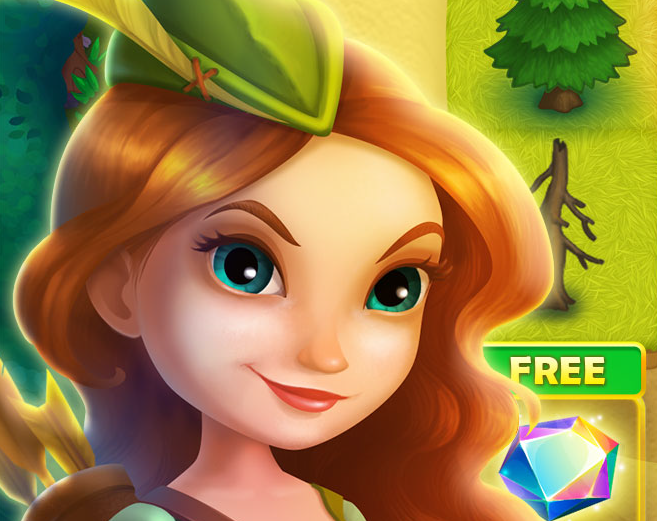
The main character of the game
3. What is the main gameplay of the game?
Neskinsoft is known in the CIS market as the author of numerous transcriptions of the game Triple Town (Spry Fox, 2010). Robin Hood Legends is no exception. This is the seventh project of the Belarusian studio, based on this mechanics, which Neskin calls “merge-3”. Only this time the developers have gone as far as possible from the original.
To begin with, let’s recall what the gameplay of Triple Town was.
Triple Town gameplay
There is a field of six by six cells. Some of the cells are empty, some are occupied by objects.

Triple Town
Items cannot be taken from the field. But the player can put on the cells those objects that were in his hand. There cannot be more than two items in the hand at a time (that is, the player puts an item and immediately the game generates the next one in his hand).
Identical items, placed close to each other in an amount of three pieces, form a new item. A new item is formed where the player placed the last missing element for the combination.
For example, three bushes disappear when placed in a row. Two cells are released. Where the last bush is placed, a tree appears.
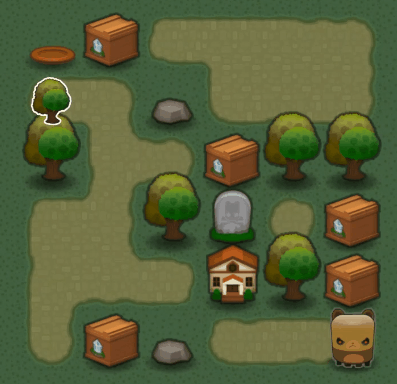
An example of how objects match in Triple Town
New formations can also be combined. Three trees give a house. Three houses — a steeper house and so on.
In addition to items, the player places bonuses and bears on the field, which interfere with the game.
The goal of Triple Town is to score the maximum number of points that are earned from combinations. The game ends at the moment when there are no more empty cells on the field.
Robin Hood Legends Innovations
Robin Hood Legends mechanics have two key changes compared to the original Triple Town.
The first is a commission structure in the spirit of Candy Crush Sada, which allowed the introduction of a number of new conditions and obstacles in the gameplay.
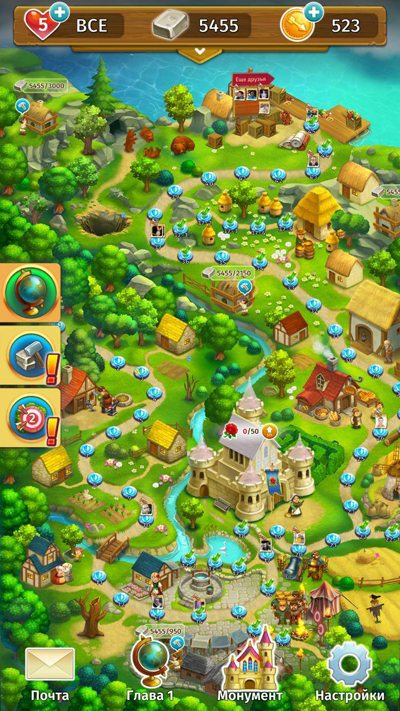
Map in Robin Hood Legends
The second is the key — when combined, the player chooses a place for the appearance of a new object within one cell from the place where the last element was placed. The latter made the game more tactful. Now, within the framework of mechanics, “bundles” have become possible.
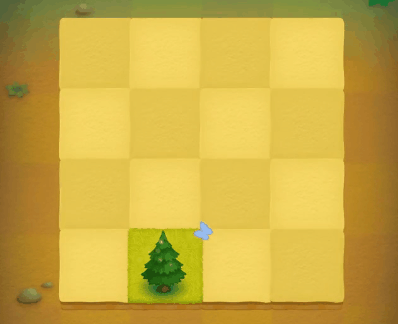
After the match in Robin Hood Legends, the player chooses a cage for staging
For example, a player prepares a situation on the field in which one combination can lead to three in a row.
Comment from the developer
The ability to choose a place for the item that turned out after the combination, according to Sergey, allowed us to very much prove the mechanics: “The original Triple Town does not forgive the player mistakes, which makes it less accessible to the casual player. In the game “Democracy”, for example, we used this restriction as one of the most important monetization features – a lawyer is ready to help the player at any time with transferring a hard-to-reach figure to any place for a symbolic 75 rubles. In Robin Hood, in order to get a more casual gameplay, we tried to allow the player to move the figure one square after the match and, as the playtests showed, this technique really worked.”
But Neskin did not come to this decision immediately. They considered another option, how to make the game easier for a wide audience.
“There were a lot of experiments. We even tried variants with a hexagonal field, which made it possible to facilitate matches by increasing the number of neighboring figures. The implementation with the ability to move the figure after the match, in our opinion, worked better, so we decided to abandon exotic hexagonal fields and other ways of proving the gameplay,” said Neskin.
Disadvantages and advantages of the basic mechanics
The main problem of gameplay is that its entry threshold is higher than that of traditional casual mechanics, like three-in-a-row or solitaire. One tap is not enough for the game here.
For a successful game, it is necessary at every step:
a) assess the situation on the field;
b) look at both objects in your hand (for this you need to drag the object from your hand into a special cell);
c) figure out where you can assemble a bundle on the field;
d) place an object in a cage with a tap;
e) in the case of a bundle, select a new cell.
This is much more interesting than playing classic match-3, but it requires more effort at the mastering stage than other mechanics in the niche require.
Comment from the developer
As it turned out in a conversation with Neskin, the studio initially understood this: “From the very beginning, we were prepared for the fact that the audience is not as familiar with mechanics as with match-3. From the very beginning of the project, active work was carried out on the first minutes of the game and tutorials.”
Now, according to Sergey, the game does not have a problem with the fall of players due to mechanics: “Our team has been intensively polishing the UX for the target audience and at the exit we received decent indicators for completing tutorials and retaining players.”
But in the early stages of development, not everything was smooth. For example, the developers did not immediately come to the conclusion that if a booster is introduced at one level, then it must be shown again at the next level in order to consolidate the material.
The developers also struggled for a long time so that players would not be drawn to swipe objects on the field. To do this, we had to add additional functionality. Now, as soon as the player tries to move the object, an arrow immediately appeared, which points to a special window from where the player should take the object.
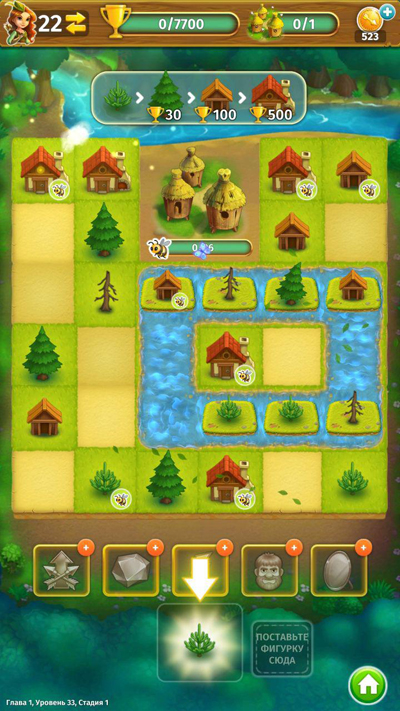
Pointer to Robin Hood Legends
The developers also managed to implement a controlled random more or less successfully. The fact is that subjectively the role of the skill in the success of the game is about 50%, the rest depends on the program of issuing items, which does not issue items absolutely randomly.
Controlled random is a convenient tool for working with complexity, as well as an important element of game design. The dynamics of the level itself, the emotions of the player and, as a result, his willingness to pay in case of loss depend on how he is configured.
And just with the last one in the game there is a problem. If the levels in Robin Hood Legends are interesting to pass, then there are very few situations in which it makes sense to use a booster or buy moves.
4. How is the meta built in the game?
The meta in this article refers to a set of secondary gameplay mechanics that are designed to structure the session and the player’s progress, and also work to improve the retention and engagement of the game.
Session gameplay
The session in the game is built in a traditional way for casual games. There is a map with levels. Passing one level opens the way to the next. This is progress.
Map
There is no single map for all levels. The project is divided into chapters.

As you progress through the game, new chapters open up
Each chapter has its own map for several dozen levels. For example, there are more than 50 levels in the first chapter.
Most likely, the reason for the division into chapters is purely technical. There is no real sense in dividing into maps. On the contrary, given that the number of resources (we will talk about them in the chapter on the economy of the game) is common to all maps, it would make sense to leave one, as is done in classic King projects.
Cards in casual games are not in trend today. Together with the rejection of replay (which we will also talk about below) and the arrival of construction and narrative mechanics, they no longer make sense.
However, it is believed that it is with the help of cards that a socially competitive element can be integrated into casual games, which theoretically can influence an increase in re-involvement. It’s about displaying the progress of friends on the map. Many companies even make special push buttons that notify the player about which of his friends beat him on the map or on points at a certain level.
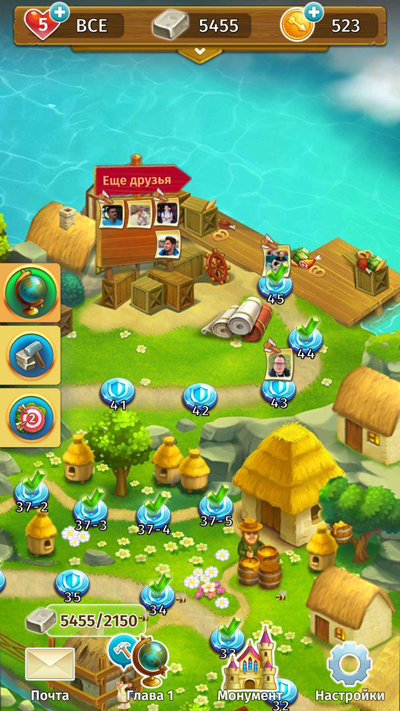
The progress of friends can be found on the map
Sometimes there are forks on the map. The player can choose one or another track of levels to complete. Freedom is fictitious. To pass on, you need to pass both.
The idea with forks is interesting. But it is “a feature for the sake of a feature.” Freedom of choice for casual players looking for routine fun for a couple of minutes is not needed.
The only sense of freedom is if both of the following levels are very difficult. So the player will have the opportunity to minimally diversify his session. He will replay more than one level dozens of times, and will be able to alternate these dozens of times. So theoretically, he is less likely to leave the game.
Quests, difficulty levels and re-passing
Passing levels in the game for progress (access to new levels on the map) is not enough. The game has progress blockers — quests.
The essence of most quests in Robin Hood Legends is the repeated passage of several levels.
The need to re—pass is a traditional tool to slow down progress, which is not customary to resort to today. This practice causes irritation among players. Irritation is far from the emotion that developers want to arouse in users.
A classic example in Robin Hood Legends: the player in the second chapter goes through levels 23, 24 and 25. After that, the player is told that he needs to build a catapult. To do this, he must collect its details. They are in the same levels that have just been passed
The first emotion after that is to quit the game.
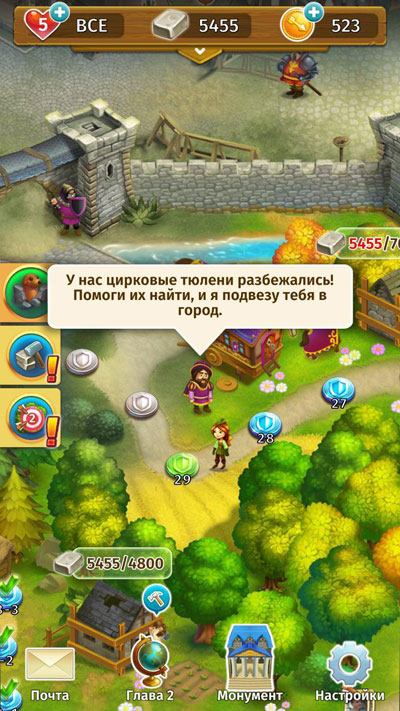
That’s how quests are given out in the game
From the point of view of analytics, this is also not the most successful approach. There are becoming too many conditions per level. In the event that they are not set, then quests will negatively affect the performance of level dumps.
In general, it is pointless to use such a practice as re—passing in casual games today. The levels already have a low cost of production, and they are created very quickly.
It makes much more sense, for example, to take a level, modify it slightly and offer it to users as a new one after 40-50 levels.
However, in the Neskinsoft game, I encourage the user to go through the levels not only within the framework of quests. Each level has three difficulties. Rewards (game currencies) are given only for the first pass on each difficulty.
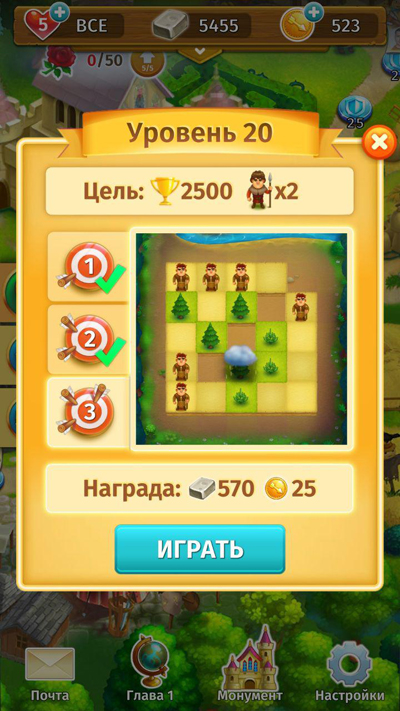
Each level has three difficulties of passing
Formally, this is a step towards a non-paying audience. Thanks to this mechanic, players can dig up game resources. However, as already mentioned, this can complicate the analytics of the game.
In addition, a more gentle practice for players would be the appearance of a rewarding video. Going through the completed levels even for the sake of additional resources is not the most pleasant pastime.
Comment from the developer
Sergey explained the situation with the replay by saying that when borrowing meta, the team did not take into account the specifics of its main gameplay.
“We usually focus on numbers. We implement the mechanics, look at the results, and then decide whether to leave it or not. Unfortunately, experiments at the meta-game level are sometimes labor-intensive, so we decided to borrow elements of a meta-game from other, perhaps not the most relevant products to date (for example, Gummy Drop).
Completing a regular level in classic match-3 is less labor-intensive for a player than completing a level in merge-3. Subjectively, in Candy Crush, the luck/skill ratio is kept within 50/50, and in merge-3, despite all the efforts to prove the gameplay, there is a strong strategic component and the luck/skill ratio feels more like 30/70, which does not affect the players’ desire to replay the levels in the best way.”
Economy
Formally, there are two main resources in the game, but in fact there is one, gold.
Gold is a hard currency that is spent on buying bonuses (for example, a mirror allows you to create a copy of any item on the map), moves (we are talking about buying five moves if they have run out) and hearts (additional purchase of hearts that are restored over time).
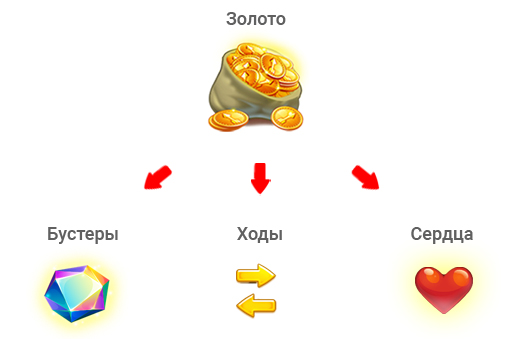
All other resources are a source of additional gold, so it is more logical to attribute them to the methods of obtaining hard currency, and not to allocate them as a separate entity.
Methods of obtaining gold:
a) Stone
The stone is spent on repairing buildings scattered on maps. Any one-time repair gives a little gold.
A stone is also given for completing levels.
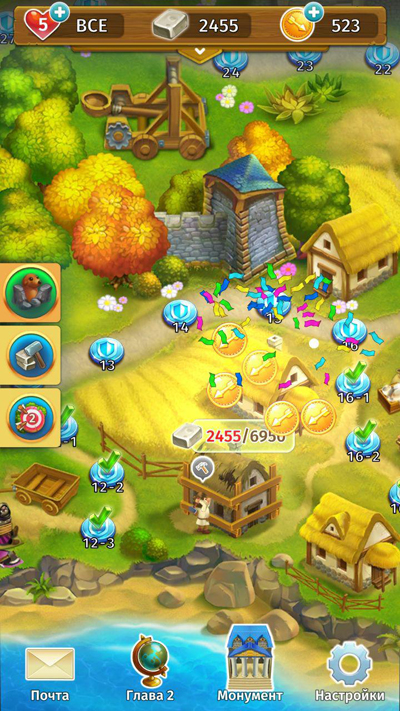
Candy and gold for repairing the building
b) Monuments
Large buildings are scattered on the maps. They are built in several stages and for their construction, objects scattered across the levels are needed.
The erection of monuments also gives gold.

Each location must have a monument, which is being built in several stages for a unique currency. The palace, for example, requires collecting paintings with Mona Lisa
c) Real money
The game has a store with six positions — from 75 rubles to 7490 rubles.
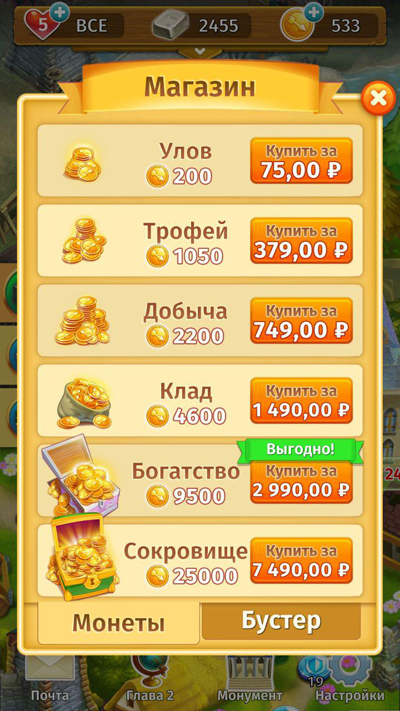
In-game store
d) Passing levels
As I mentioned just above, each level has three difficulties. At the first pass, access is given to the second difficulty, at the second pass — to the third. At the first pass, a certain amount is given for each difficulty. The higher the difficulty, the greater the reward.
f) Quests
There are two types of quests in the game. Temporary and permanent. They differ from each other only by the presence of a timer. Both types give gold for the execution.
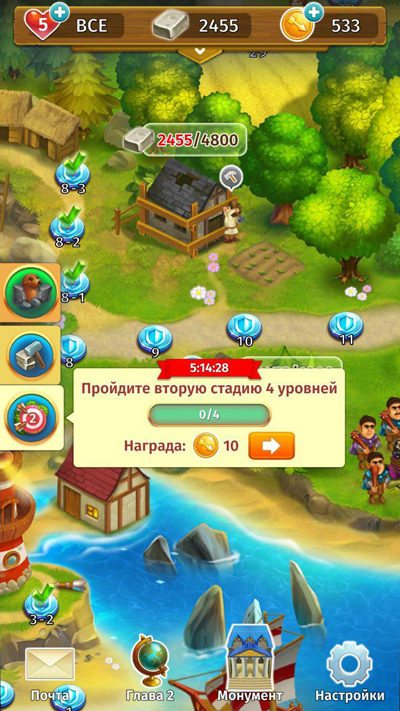
Temporary Quest
f) Chests
During the game, several coins can be poured out of the chests (a type of obstacle that opens and disappears after the player matches several items).
Adding additional resources to the role of consumables for the main currency is an original move that allowed you to diversify the gameplay, but did not radically complicate the meta. Moreover, this element is so optional that it can be ignored.
The economy in the game is built in such a way that the non-paying audience has the opportunity to earn gold for completing difficult levels, but at the same time there would still be a large shortage of this resource.
In other words, it takes a long time to extract gold, and the prices for consumables are high.
For example, 5 gold and 500 stones are given for the initial completion of the level. For the restoration of the 1200 stone building — 10 gold. For quests that require several hours to complete — from 10 gold. At the same time, one bonus will cost you 200 gold coins.
That is, in order for a player to get a bonus that will allow him to pass a difficult level (or buy hearts), he will need to pass 40 levels. Or about half as much if he will also be engaged in construction.
Developer’s Comment
“We considered many options, at some point we even tried to introduce a piggy bank into which the gold coins earned at the levels flew away. In the game, as a result, they left the most effective and, as it turned out, the simplest option. We are not going to shock our players, further experiments will take place within the framework of our next projects.”
5. What does the developer earn in the game?
As we noted just above, there are six IAPs in the game. These are lots with gold. There is nothing else to buy directly in the game. The system itself with a shortage of the main resource is transparent and standard for such projects.
Also, there is no advertising in any form in the game. There is no rewarding video, no cross-banners. Considering that the project has less than 1 million downloads in total on both platforms, most likely, this does not make sense here yet.
6. Problems of the game
In addition to the insufficiently bright graphics, the need to regularly return to the completed levels, as well as the high entry threshold, the game has one critical problem. In modern three-in-a-row, they do everything so that the player does not get bored. To do this, new elements are introduced into the gameplay as often as possible (chocolate, ice, soda, and so on).
This is very rarely done in Robin Hood Legends. Therefore, it seems that the levels are devoid of uniqueness and similar to each other.
Developer’s Comment
Neskin does not agree that the game lacks a mechanic.
“If I’m not mistaken, we currently have about 25 game mechanics at 7 locations. On average, we introduce about two mechanics per location. The exception is the first location, where they are introduced more intensively. Next, we focus on all possible combinations, trying not to overload the player with new behaviors.”
Another controversial point is that on each map (chapter/location) the elements look different. For example, on the first map the bushes and trees are one, and on the second map they are completely different. Yes, it brings variety, but with it stress.

The first row — elements from the first chapter, the second row — from the second
The player has just adjusted to the objects on the map and is waiting for new mechanics, as he is offered to get used to the elements again. At the same time, the rules do not change. Bushes still gather into trees, trees into houses, houses into manors, and so on.
In addition to the fact that this may increase the gap between chapters, this decision may have significantly increased the cost of production.
Developer’s Comment
“In fact, it was just one of the ways to support visual diversity in the project. Unlike the classic match-3, where the player destroys figures with matches, in merge-3 gameplay, a new figure is created as a result of the match, which fundamentally affects perception.
Among the disadvantages of the implementation of the playing field, I can note some out of sync with the previously adopted epic goal – we defeat tyranny on the map, and we are engaged in construction on the playing field. At some point, the guys decided to work out other concepts that fit better with meta, but they all complicated decision-making in evolutionary chains, so they had to put up with a simpler and more understandable construction for the player.”
7. Results
According to DataMagic, the game earned more than $60 thousand in July alone.

The project turned out to be quite curious and interesting. However, there are still many questions to him, some of which are shared by the team.
When asked if Sergey is happy with the project, he replied that he would like to achieve better replayability and reduce the cost of producing new content by making more optimal DG decisions.
That’s it. We look forward to comments and questions from readers.
